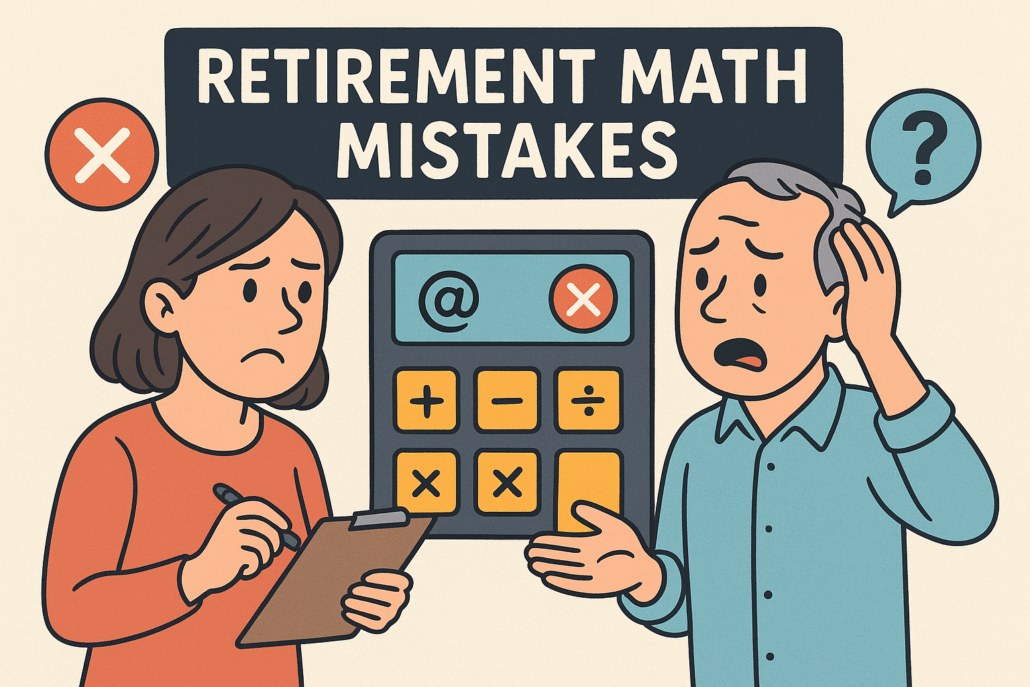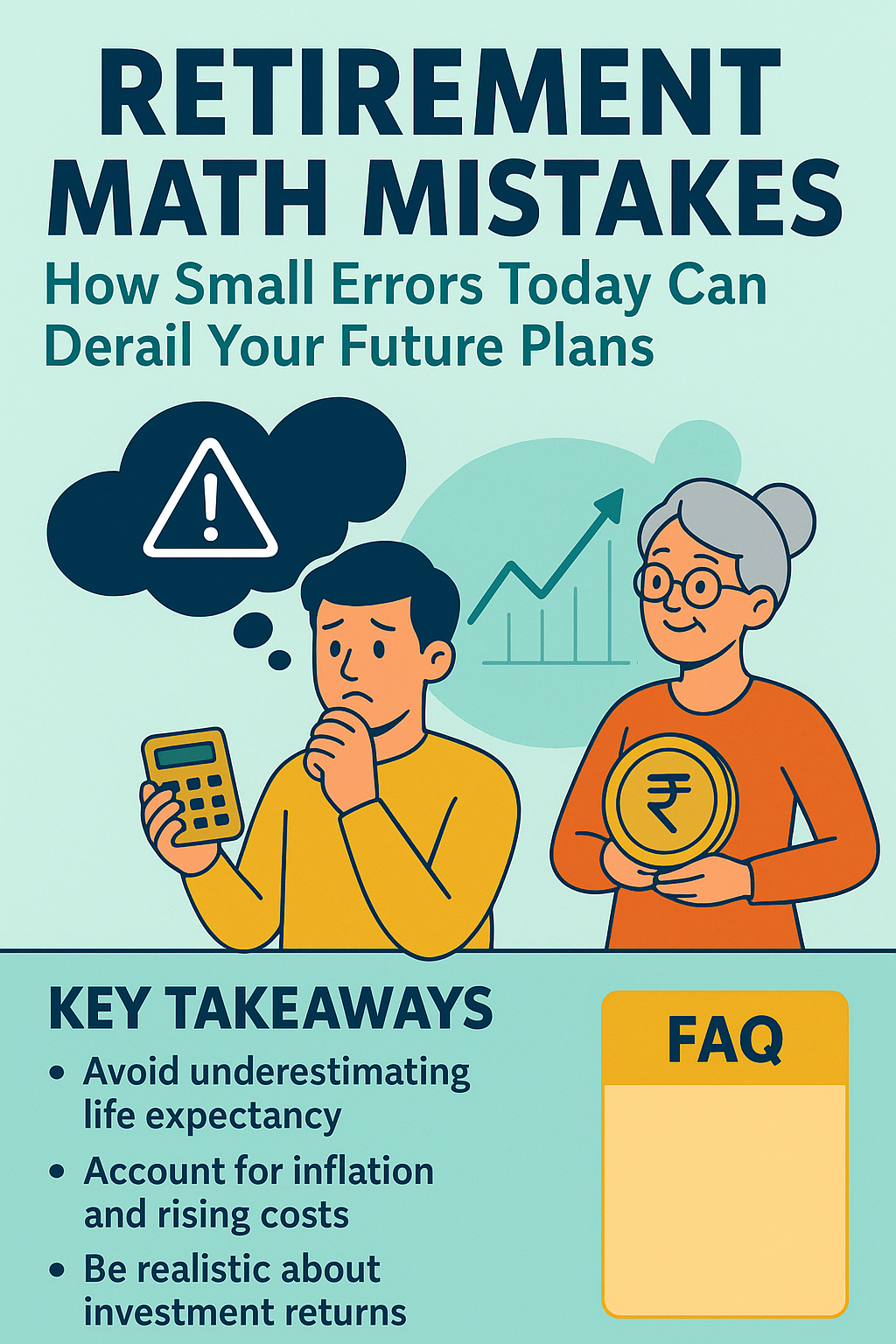When it comes to planning for retirement, even tiny errors in your math today can cascade into massive shortfalls decades later. Many people assume retirement is just a numbers game — pick a target, save “some figure,” invest, and you retire. But the truth is that retirement math mistakes are easy to make, and they can derail your future plans if left unchecked.
In this blog post, we’ll explore the most common retirement math mistakes, how they occur, and how to safeguard your golden years. By learning about these pitfalls, you can avoid them and build a reliable retirement plan.
Why Small Errors Matter in Retirement Planning
Retirement planning is highly sensitive to assumptions. A slight miscalculation early on—not factoring in inflation, overestimating returns, underestimating life expectancy—can lead to a dramatic shortfall later. Because compounding magnifies small assumptions, a 1% error today can translate into tens or hundreds of thousands of rupees in deficit in 20–30 years.
Let’s dig into the most common retirement math mistakes and how to avoid them.
1. Underestimating Life Expectancy
One of the biggest retirement math mistakes is assuming you won’t live long. Many retirees base their plans on shorter life spans, which causes them to draw down savings too quickly. With increasing life expectancy, it’s not uncommon to live 20–30 years or more after retirement. Failing to plan for that extended period can exhaust your corpus prematurely.
How to avoid this mistake:
-
Use conservative, longer lifespans (e.g. 90–95 years) in your calculations
-
Build buffers for additional decades
-
Review periodically as medical advances and personal health evolve
2. Ignoring Inflation & Rising Costs
Another core error: not accounting for inflation. ₹1 crore today may be far less valuable 20 years later. Without factoring inflation, your retirement corpus might lose purchasing power. Moreover, post-retirement, some costs (like healthcare) tend to rise faster than general inflation.
Precautions you can take:
-
Use inflation assumptions (e.g. 4–6% annually) in your models
-
Choose investments that can beat inflation (equities, inflation-indexed bonds)
-
Revisit and adjust projections regularly
3. Overestimating Investment Returns
Optimism bias leads many to assume very high returns. But markets are volatile, and returns are never guaranteed. If you assume too aggressive returns, you risk creating a false sense of security. When actual returns fall short, the gap can be huge.
How to guard against this:
-
Use conservative return estimates (e.g. 6–8% real, not nominal)
-
Stress test your retirement plan with worse-case scenarios
-
Diversify your portfolio to reduce volatility risk
4. Neglecting Healthcare & Unexpected Costs
Medical costs often escalate in old age. Many retirees fail to include realistic healthcare expenses, emergencies, or other surprises (home repair, caregiving, travel). Ignoring these is a serious retirement math mistake.
Mitigation strategies:
-
Allocate a contingency or emergency fund
-
Get health / critical illness insurance well in advance
-
Regularly increase the healthcare portion in your projections
5. Delaying Your Retirement Savings
One of the most damaging mistakes is delaying the start of your retirement savings. The earlier you begin, the more time compounding has to work. Delays mean you must save much more later to catch up.
Best practices:
-
Start as early as possible — even small amounts help
-
Automate contributions (SIP, recurring transfers)
-
Try not to pause or withdraw prematurely
6. Failing to Revisit & Adjust
Even with a good plan, markets and personal situations change. Sticking rigidly to assumptions is another subtle mistake. Failure to review and adjust your retirement math can lead to underperformance or gaps.
How to maintain flexibility:
-
Review your retirement plan annually
-
Adjust assumptions (inflation, returns, longevity) based on new data
-
Rebalance your portfolio and reforecast projections
Sample Illustration: The Impact of a 1% Error
Let’s see a quick illustration of how a 1% error compounds:
-
Suppose you plan to retire in 25 years and estimate a 7% return, but the real return ends up being 6%. That 1% drift might reduce your final corpus by 20–30% or more.
-
If your plan was for ₹2 crores, you might end up with only ₹1.4–1.6 crores — leaving a significant shortfall.
This shows how even small math mistakes compound over time.
A Checklist to Avoid Retirement Math Mistakes
| Risk / Mistake | What to Do | Frequency |
|---|---|---|
| Underestimating lifespan | Use conservative age assumptions | At plan creation & reviews |
| Ignoring inflation | Include inflation in every projection | Annually |
| Overestimating returns | Use stress tests / conservative returns | At every recalculation |
| Underestimating health costs | Budget a contingency + insurance | Annually |
| Delaying contributions | Automate and start early | Immediately |
| Not adjusting plan | Revisit, revise, rebalance | Yearly or biennial |
Conclusion
Retirement is not just a dream — it’s a long horizon plan that depends critically on sound math. Retirement math mistakes, even seemingly small ones, can multiply into serious shortfalls over decades. By accounting for inflation, realistic returns, healthcare costs, life expectancy, and starting early — plus revisiting your plan — you can significantly reduce the risk that your golden years fall short of your goals.
![]()



